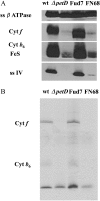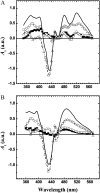The requirement for carotenoids in the assembly and function of the photosynthetic complexes in Chlamydomonas reinhardtii
- PMID: 23161889
- PMCID: PMC3532283
- DOI: 10.1104/pp.112.205260
The requirement for carotenoids in the assembly and function of the photosynthetic complexes in Chlamydomonas reinhardtii
Abstract
We have investigated the importance of carotenoids on the accumulation and function of the photosynthetic apparatus using a mutant of the green alga Chlamydomonas reinhardtii lacking carotenoids. The FN68 mutant is deficient in phytoene synthase, the first enzyme of the carotenoid biosynthesis pathway, and therefore is unable to synthesize any carotenes and xanthophylls. We find that FN68 is unable to accumulate the light-harvesting complexes associated with both photosystems as well as the RC subunits of photosystem II. The accumulation of the cytochrome b₆f complex is also strongly reduced to a level approximately 10% that of the wild type. However, the residual fraction of assembled cytochrome b₆f complexes exhibits single-turnover electron transfer kinetics comparable to those observed in the wild-type strain. Surprisingly, photosystem I is assembled to significant levels in the absence of carotenoids in FN68 and possesses functional properties that are very similar to those of the wild-type complex.
Figures





Similar articles
-
Novel thylakoid membrane GreenCut protein CPLD38 impacts accumulation of the cytochrome b6f complex and associated regulatory processes.J Biol Chem. 2013 Mar 8;288(10):7024-36. doi: 10.1074/jbc.M112.427476. Epub 2013 Jan 9. J Biol Chem. 2013. PMID: 23303190 Free PMC article.
-
Photosynthetic membrane organization and role of state transition in cyt, cpII, stt7 and npq mutants of Chlamydomonas reinhardtii.J Photochem Photobiol B. 2014 Aug;137:77-83. doi: 10.1016/j.jphotobiol.2014.03.025. Epub 2014 Apr 24. J Photochem Photobiol B. 2014. PMID: 24836759
-
Structure of Photosystem I Supercomplex Isolated from a Chlamydomonas reinhardtii Cytochrome b6f Temperature-Sensitive Mutant.Biomolecules. 2023 Mar 15;13(3):537. doi: 10.3390/biom13030537. Biomolecules. 2023. PMID: 36979472 Free PMC article.
-
The cytochrome b6f complex at the crossroad of photosynthetic electron transport pathways.Plant Physiol Biochem. 2014 Aug;81:163-83. doi: 10.1016/j.plaphy.2013.12.011. Epub 2013 Dec 27. Plant Physiol Biochem. 2014. PMID: 24485217 Review.
-
Regulation of the photosynthetic apparatus under fluctuating growth light.Philos Trans R Soc Lond B Biol Sci. 2012 Dec 19;367(1608):3486-93. doi: 10.1098/rstb.2012.0067. Philos Trans R Soc Lond B Biol Sci. 2012. PMID: 23148275 Free PMC article. Review.
Cited by
-
Photosynthesis-related quantities for education and modeling.Photosynth Res. 2013 Nov;117(1-3):1-30. doi: 10.1007/s11120-013-9945-8. Epub 2013 Oct 26. Photosynth Res. 2013. PMID: 24162971 Review.
-
Effects of marine actinomycete on the removal of a toxicity alga Phaeocystis globose in eutrophication waters.Front Microbiol. 2015 May 19;6:474. doi: 10.3389/fmicb.2015.00474. eCollection 2015. Front Microbiol. 2015. PMID: 26042109 Free PMC article.
-
Understanding chloroplast biogenesis using second-site suppressors of immutans and var2.Photosynth Res. 2013 Oct;116(2-3):437-53. doi: 10.1007/s11120-013-9855-9. Epub 2013 May 24. Photosynth Res. 2013. PMID: 23703455 Review.
-
Suppression of the Lycopene Cyclase Gene Causes Downregulation of Ascorbate Peroxidase Activity and Decreased Glutathione Pool Size, Leading to H2O2 Accumulation in Euglena gracilis.Front Plant Sci. 2021 Dec 3;12:786208. doi: 10.3389/fpls.2021.786208. eCollection 2021. Front Plant Sci. 2021. PMID: 34925426 Free PMC article.
-
Diverse Biosynthetic Pathways and Protective Functions against Environmental Stress of Antioxidants in Microalgae.Plants (Basel). 2021 Jun 19;10(6):1250. doi: 10.3390/plants10061250. Plants (Basel). 2021. PMID: 34205386 Free PMC article. Review.
References
-
- Agalarov R, Brettel K. (2003) Temperature dependence of biphasic forward electron transfer from the phylloquinone(s) A1 in photosystem I: only the slower phase is activated. Biochim Biophys Acta 1604: 7–12 - PubMed
-
- Ali K, Santabarbara S, Heathcote P, Evans MCW, Purton S. (2006) Bidirectional electron transfer in photosystem I: replacement of the symmetry-breaking tryptophan close to the PsaB-bound phylloquinone A1B with a glycine residue alters the redox properties of A1B and blocks forward electron transfer at cryogenic temperatures. Biochim Biophys Acta 1757: 1623–1633 - PubMed
-
- Bassi R, Pineau B, Dainese P, Marquardt J. (1993) Carotenoid-binding proteins of photosystem II. Eur J Biochem 212: 297–303 - PubMed
-
- Bautista JA, Rappaport F, Guergova-Kuras M, Cohen RO, Golbeck JH, Wang JY, Béal D, Diner BA. (2005) Biochemical and biophysical characterization of photosystem I from phytoene desaturase and zeta-carotene desaturase deletion mutants of Synechocystis sp. PCC 6803: evidence for PsaA- and PsaB-side electron transport in cyanobacteria. J Biol Chem 280: 20030–20041 - PubMed
-
- Beal D, Rappaport F, Joliot P. (1999) A new high-sensitivity 10-ns time-resolution spectrophotometric technique adapted to in vivo analysis of the photosynthetic apparatus. Rev Sci Instrum 70: 202–207
Publication types
MeSH terms
Substances
Grants and funding
LinkOut - more resources
Full Text Sources

